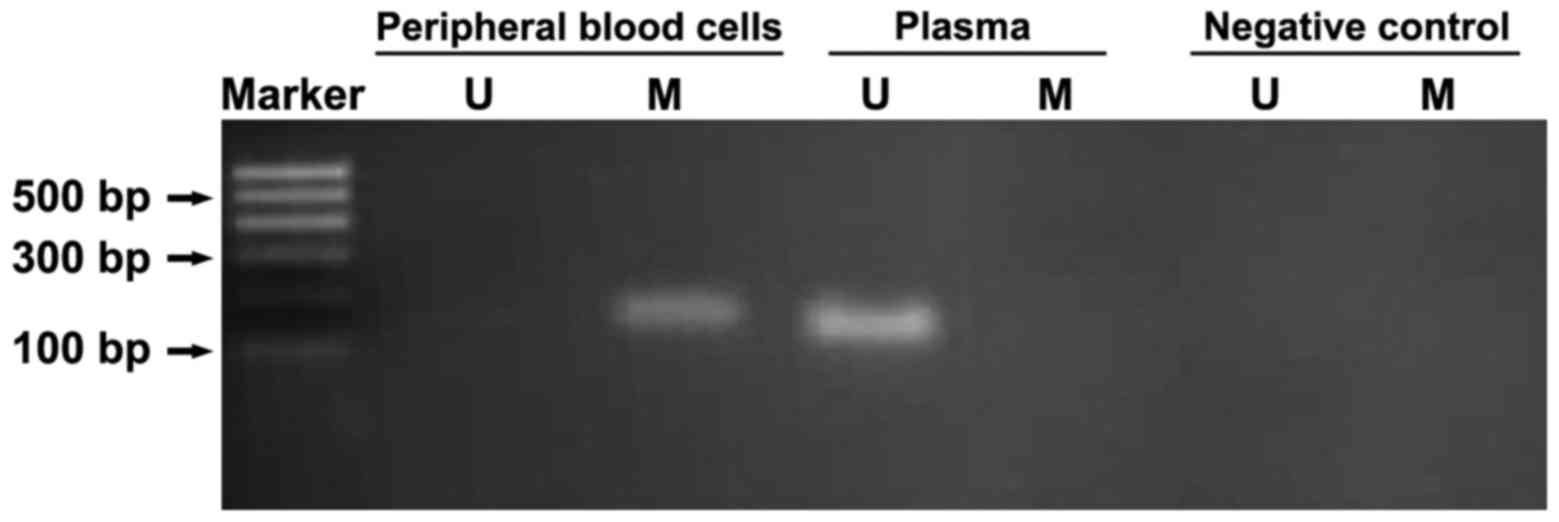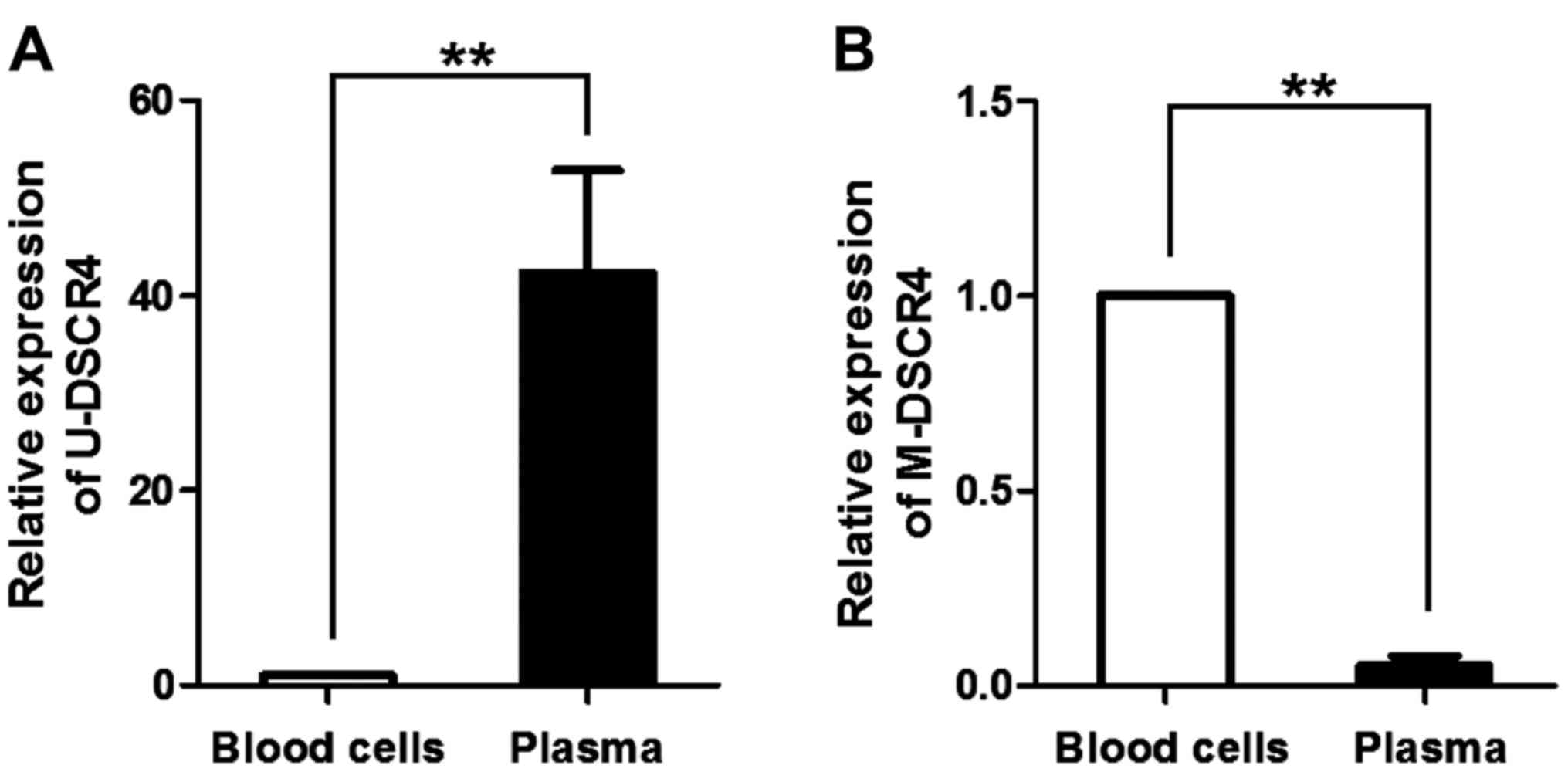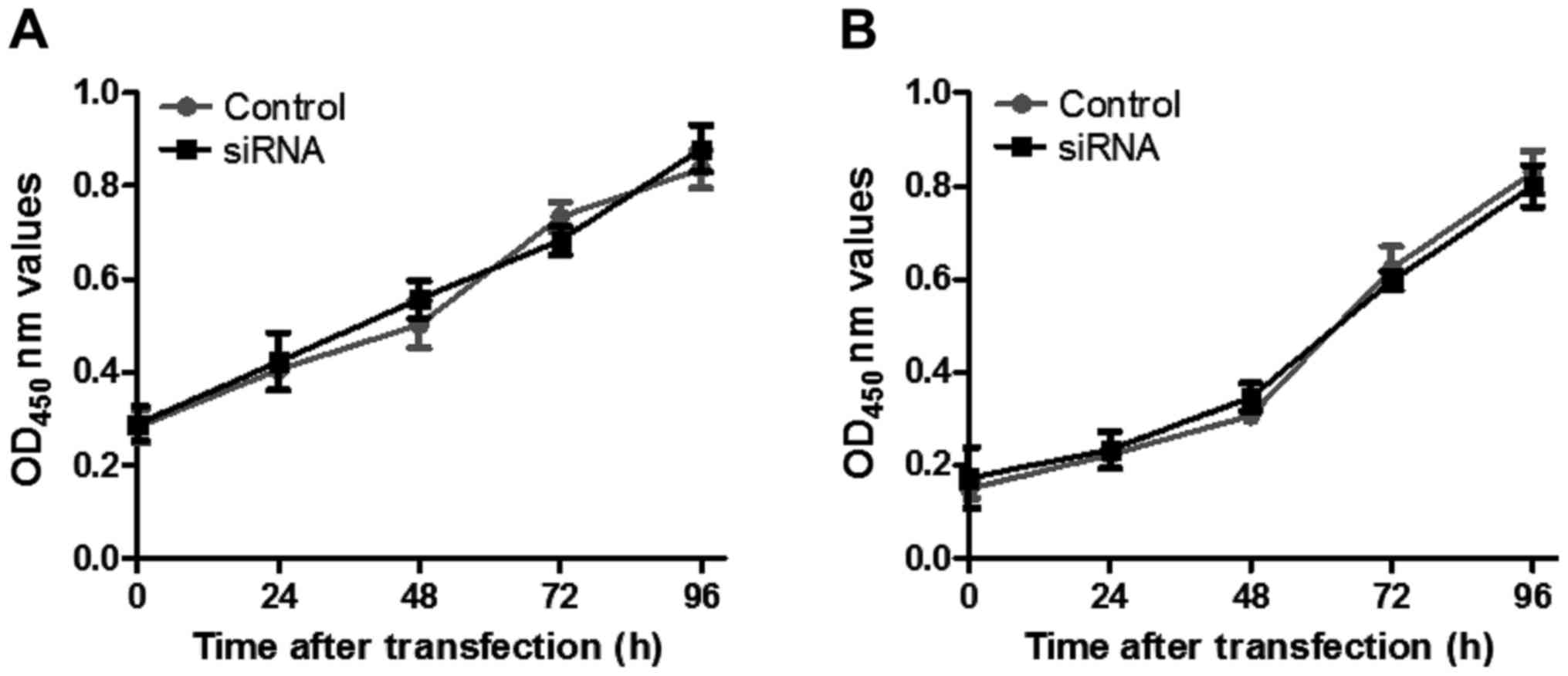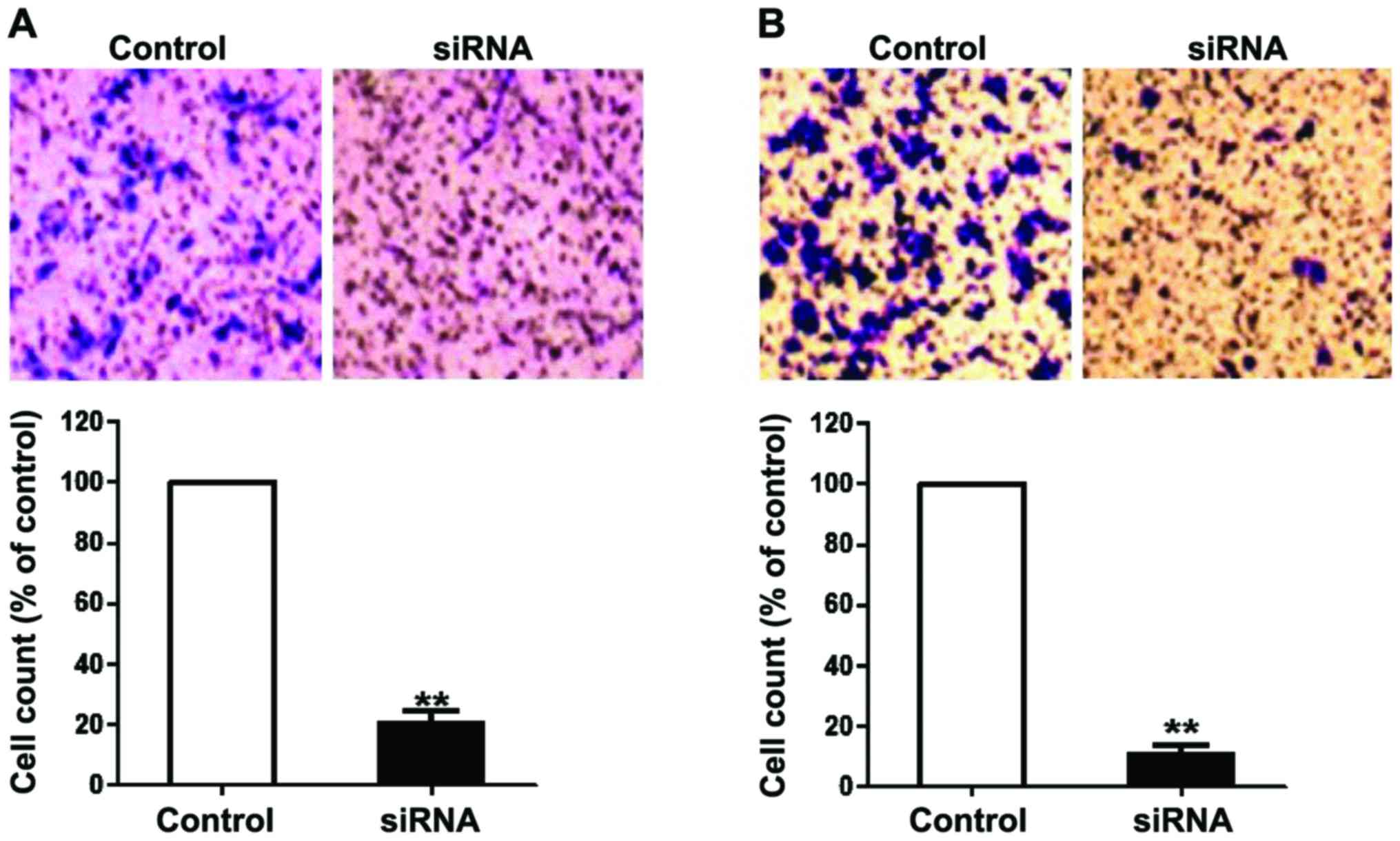Association between DSCR4 gene methylation in plasma in early pregnancy and Down's syndrome
- Authors:
- Published online on: January 16, 2018 https://doi.org/10.3892/etm.2018.5754
- Pages: 2749-2754
-
Copyright: © Hu et al. This is an open access article distributed under the terms of Creative Commons Attribution License.
Abstract
Introduction
Down's syndrome (DS), or 21-trisomy syndrome, is a kind of chromosomal abnormal genetic disease caused by a local or total copy of chromosome 21, whereby patients suffer from delayed body growth, special facies, mild to moderate mental retardation and other symptoms, seriously affecting the life of patients (1). According to statistics, approximately 1 of 1,000 infants is inflicted by this disease annually, and the mortality rate of DS patients reached 0.5% in 2015 (2). The fundamental way to reduce DS risk is to avoid the birth of newborn patients; thus, prenatal screening for pregnant women is imperative. At present, the conventional method for the prenatal examination of DS is the amniotic cell chromosome analysis, in which fetal cells are obtained via B ultrasound-guided puncture of the amniotic cavity for karyotype analysis. However, this method is invasive and the fetal loss rate is high. Consequently, the majority of high-risk pregnant women refuse this method (3).
In previous years, non-invasive DS prenatal diagnosis techniques have been developed, including ultrasound diagnosis, karyotype analysis of peripheral blood cell chromosome in pregnant women, and peripheral-free fetal nucleic acid analysis, of which free fetal nucleic acid has rapidly become developed as a method in the prenatal diagnosis of DS (4). Free fetal nucleic acid is characterized by rich content and stable existence in the peripheral blood of pregnant women (5), and is more suitable for the DS prenatal diagnosis. However, the maternal nucleic acid also exists in peripheral blood, and is essential to distinguish maternal from fetal nucleic acid. Findings have shown that the maternal nucleic acid in peripheral blood is derived from hematopoietic cells, while the free fetal nucleic acid is derived from placental trophocytes. Owing to the different tissues, the level of DNA methylation is also different between them (6,7), which can provide new ideas for the study on DS prenatal diagnosis and maternal-fetal epigenetic differences.
Down's syndrome critical region 4 (DSCR4) gene is a kind of highly expressed gene in placenta and is expressed in human choriocarcinoma cell lines JEG3 and BeWo. DSCR4 is located in the DSCR region on chromosome 21q22.2 (8). Previous findings showed that obstacles are formed in the syncytiotrophoblast in the placenta of DS patients. Thus, the process of secretion of hormones in the maternal circulation is affected (9). DSCR4 is located in DSCR and expressed in placental tissues and plays a unique role in placental development and participates in the pathological process of DS. In addition, the expression level of DSCR4 is related to the methylation level in its promoter region, and there is also a difference in methylation between maternal and fetal DNA (10). Therefore, DSCR4 gene methylation is a characteristic marker with maternal-fetal epigenetic differences.
The aim of the study was to examine the association between the DSCR4 gene methylation level in plasma in high-risk pregnant women with DS in early pregnancy (hereinafter referred to as pregnant women in early pregnancy) and DS in order to screen the biomarkers with maternal-fetal epigenetic differences for the non-invasive prenatal diagnosis of DS and provide new perspectives for the prognosis and treatment of DS.
Materials and methods
General data
Twenty pregnant women in early pregnancy, admitted to Outpatient Department in The Third Xiangya Hospital of Central South University (Hunan, China) from January 2016 to May 2016 were included in the study. All 20 were high-risk pregnant women with DS with a gestation period of 8–12 weeks, age of 28.45±3.77 years and weight of 108.43±17.83 kg. Subjects were spontaneously pregnant with single birth for the first time without pregnancy complications, medical and surgical diseases, tumors or other diseases.
Study participation was agreed to by the subjects and the informed consent form was signed. The present study was approved by the Ethics Committee of The Third Xiangya Hospital of Central South University.
Main reagents
Human choriocarcinoma cell lines JEG3 and BeWo were purchased from Cobioer Biosciences (Nanjing, China). An EZ DNA methylation-gold kit (Zymo Research Corp., Irvine, CA, USA); QIAamp DNA mini and DNA blood mini kit (both from Qiagen, Inc., Valencia, CA, USA); TaqαI, TRIzol reagent, Prime Script® RT reagent kit with gDNA Eraser and SYBR® Premix Ex Taq™ II (all from Takara Biotechnology Co., Ltd., Dalian, China); F12, Dulbecco's modified Eagle's medium (DMEM) and Lipofectamine 2000 (both from Invitrogen; Thermo Fisher Scientific, Inc., Waltham, MA, USA); Cell Counting kit-8 (CCK-8) (Dojindo Molecular Technologies, Inc., Kumamoto, Japan); and primers (Shanghai Shenggong Biology Engineering Technology Service, Ltd., Shanghai, China) were used in the present study.
Extraction of DNA in peripheral blood cells and plasma
Fresh peripheral blood (4 ml) was drawn from pregnant women in early pregnancy, and the plasma and blood cells were completely isolated via centrifugation after ethylene diamine tetraacetic acid was added for anticoagulation. Isopyknic phosphate-buffered saline was added into the blood cells to resuspend the cells, while a sodium dodecyl sulfonate lysis buffer was added into the plasma. After incubation at 37°C for 2 h and ultrafiltration centrifugation, poly d(T)18 was added and mixed evenly. DNA in blood cells and plasma was extracted according to the instructions of QIAamp DNA mini and DNA blood mini kit.
Hydrosulphite treatment
DNA (400 ng) in blood cells and plasma was taken quantitatively and the water was complemented until 20 µl. The solution was treated with hydrosulphite according to the instructions of the EZ DNA methylation-gold kit. The products were eluted for subsequent experiments.
Methylation-specific polymerase chain reaction (MSP)
DNA (2 µl) in blood cells, and 2 µl DNA in plasma after hydrosulphite treatment were taken, and the PCR amplification system and reaction process were optimized routinely. The gene coding regions of undermethylated DSCR4 (U-DSCR4) and hypermethylated DSCR4 (M-DSCR4) were amplified using the hot-start method. The amplification products were 148 and 143 bp, and they were observed via electrophoresis and photographed. The primer sequences are shown in Table I.
Restriction endonuclease analysis
The amplification product gel was recycled and 500 ng gel was taken and added with 10 U TaqαI endonuclease. After incubation via water bath at 65°C for 2 h, the enzyme-digested products were observed via 2% agarose gel electrophoresis and photographed. At the same time, the non-enzyme digestion group was set as a control.
Reverse transcriptase-quantitative PCR (RT-qPCR) analysis
The reverse transcriptase-quantitative methylation-specific PCR (RT-qMSP) reaction system was prepared using hydrosulphite-treated DNA in blood cells and plasma as the template according to the protocol of the kit. Additionally, this DNA was detected in CFX-96 real-time PCR detection system (Bio-Rad Laboratories, Inc., Hercules, CA, USA). Data were collected and treated in the relative expression form using the comparative cycle threshold method. β-actin was taken as the internal reference. The primer sequences are shown in Table I.
Cell transfection
The DNA-Lipofectamine 2000 complex was prepared as per the instructions of Lipofectamine 2000, and the diluted plasmid DNA was mixed with Lipofectamine 2000 at a ratio of 1/2-1/3 (µg/µl). The mixture was placed at room temperature for 20 min, and for another 10 min at room temperature after small interfering RNA (siRNA) oligo was added. The mixture was added into the 96-well plates and incubated with CO2 at 37°C for 24–48 h. The transfected cells were used for subsequent experiments, and the siRNA sequences of DSCR4 are shown in Table I.
Cell proliferation analysis
The transfected cells (5×103) were inoculated onto the 96-well plate according to the instructions of the CCK-8 kit. CCK-8 solution (10 µl) was added into each well at 0, 1, 2, 3 and 4 days and incubated at 37°C for 2 h. Absorbance was measured at 450 nm.
Cell invasion and migration analysis
The artificial basement membrane was added into the culture wells. DMEM containing 3×104 cells after transfection for 48 h was inoculated into the upper chamber of the basement membrane, while the lower chamber was filled with DMEM containing 20% fetal bovine serum. After incubation for 24 h, the membrane was fixed with 4% methanol and stained with 0.1 % crystal violet three times, followed by cell migration analysis.
Statistical analysis
Statistical analysis was performed using SPSS 17.0 (SPSS, Chicago, IL, USA). The experiments were repeated three times and the data were presented as mean ± standard deviation. Kruskal-Wallis one-way analysis of variance and a two-tailed t-value test were performed between groups. P<0.05 was considered to indicate a statistically significant diference.
Results
Methylation difference of DSCR4 gene in peripheral blood DNA in high-risk pregnant women with DS
MSP was performed for the hydrosulphite-treated DNA in peripheral blood cells and plasma of pregnant women in early pregnancy to amplify U-DSCR4 and M-DSCR4. U-DSCR4 was detected in plasma, but not in blood cells, whereas M-DSCR4 was detected in peripheral blood cells in pregnant women, but not in plasma, indicating that there is a difference in the methylation level between DSCR4 genes in peripheral blood and plasma in high-risk pregnant women with DS (Fig. 1).
Verification of the methylation difference of DSCR4 in peripheral blood DNA via restriction endonuclease
The methylation difference of DSCR4 between peripheral blood cells and plasma in high-risk pregnant women with DS was verified via restriction endonuclease analysis. Since the TaqαI recognition site was TCGA, if C in CpG was unmethylated, the amplification product would mutate into T following hydrosulphite treatment, changing the digestion site and disabling TaqαI digestion. Fig. 2 shows that the DSCR4 amplification products in peripheral blood cells in pregnant women were digested under the action of TaqαI, and the enzyme-digested products were 102 and 130 bp, indicating that DSCR4 is in a hypermethylated status in peripheral blood cells. However, the products in plasma were not digested, suggesting that DSCR4 is in an unmethylated status in plasma.
Expression of DSCR4 with different methylation levels in the peripheral blood of pregnant women
The expression levels of U-DSCR4 and M-DSCR4 in peripheral blood cells and plasma of pregnant women in early pregnancy were detected via RT-qPCR. The expression level of U-DSCR4 in plasma was significantly higher than that in blood cells (Fig. 2A), U-DSCR4 mainly existed in plasma DNA. However, the expression level of M-DSCR4 in plasma was obviously lower than that in blood cells, M-DSCR4 mainly existed in blood cell DNA (Fig. 2B).
Effect of DSCR4 on cell proliferation
The proliferation of JEG3 and BeWo cells transfected with DSCR4 siRNA was detected via CCK-8. There was no significant effect on the proliferation of JEG3 and BeWo cells in the DSCR4 intervention group compared with that in the control group (Fig. 3).
Effect of DSCR4 on cell invasion and migration
The invasion and migration of JEG3 and BeWo cells transfected with DSCR4 siRNA for 48 h were analyzed. The results showed that the intervention in DSCR4 expression significantly decreased the invasion and migration capacities of JEG3 and BeWo cells compared with the control group, indicating that DSCR4 can promote the invasion and migration of JEG3 and BeWo cells (Fig. 4).
Discussion
DS is a kind of chromosomal abnormal disease, and patients often suffer from dysplasia, immune system defects and mental retardation accompanied with congenital heart disease (11). The diagnosis and treatment of DS poses a significant financial burden on the patient's family. At present, the commonly used diagnostic method is invasive examination of pregnant women based on serological screening. However, this method has varying shortcomings and the establishment of non-invasive prenatal diagnosis is imperative to resolved this issue. Lo et al used the heterozygous SNP on the PLAC4 mRNA specifically expressed in placenta to calculate the ratio of PLAC4 allele for DS diagnosis, but the detection rate was low (12). This method provides a new idea for the free fetal nucleic acid in peripheral blood of pregnant women as a target for a non-invasive DS diagnosis.
Therefore, it is crucial to differentiate fetal from maternal DNA in peripheral blood. Previous findings have shown that the methylation level of the SERPINB5 gene promoter region on chromosome 18q21.3 has a difference between peripheral blood cells and placental tissues of pregnant women, the former of which exists in a hypermethylated state, and the latter of which exists in an undermethylated state and can be considered as coming from the fetus (13). Consequently, maternal DNA methylation differences can be used as a key factor in distinguishing maternal-fetal DNA. DNA methylation is a common form of epigenetic modification, which adds methyl selectively on C of the CG dinucleotide through the effect of methyltransferase. As a result, the gene sequence does not change, albeit the heritable changes occur to the gene expression (14). At present, placental-derived non-methylated genes, such as U-SERPINB5 and U-RASSF1A, can be successfully detected in the free nucleic acid in plasma of pregnant women and used in clinical diagnosis (15,16).
Since the pathogenesis basis of DS is the local or total copy of chromosome 21, screening the genes with maternal-fetal methylation differences on chromosome 21 is beneficial to reveal the pathological process and molecular mechanisms of DS and provide new targets for the prenatal diagnosis of DS. Chim et al systematically studied the marker sequences with maternal-fetal methylation differences on chromosome 21 (17). The findings showed that the fetal HLCS gene on chromosome 21 is hypermethylated and can be used to detect DS in male fetuses (18). In addition, studies have shown that there is a region of 5.4 Mb in length on chromosome 21q22.2 known as DS critical region (19). This region includes a variety of DS-related genes, of which DSCR4 is specifically expressed in placenta and may be associated with the abnormal placental trophoblast of DS, and involved in the regulation of the pathological process of DS (20).
Findings of this study indicated that there was a difference in methylation of DSCR4 gene in peripheral blood DNA in high-risk pregnant women with DS in early pregnancy. DSCR4 was in an undermethylated status in plasma and in a hypermethylated status in blood cells. The peripheral blood DNA contains both maternal and free fetal DNA, of which the maternal nucleic acid comes from the hematopoietic cells and mainly exists in the blood cells, and the free fetal nucleic acid is derived from the placental trophoblast cells and mainly exists in plasma (6,7). Thus, there is a difference in the methylation level of DSCR4 in maternal DNA, and DSCR4 can be used as a biomarker for DS prenatal diagnosis and distinguishing maternal-fetal epigenetic differences. In general, the degree of DNA methylation is negatively correlated with gene expression, and our findings also revealed that U-DSCR4 was highly expressed in the plasma of pregnant women in early pregnancy, indicating it was highly expressed in fetal DNA. M-DSCR4 was highly expressed in blood cells, indicating it was highly expressed in maternal DNA. Thus, U-DSCR4 is an epigenetic specific marker of fetal DS. In addition, the intervention in DSCR4 expression suppressed the invasion and migration of trophoblast cells, but had no effect on cell proliferation, suggesting that DSCR4 regulates the abnormality of DS placental trophoblast by promoting cell migration and invasion and plays a role in early placental development. In conclusion, this study provided a theoretical basis for the non-invasive prenatal diagnosis of DS and screened new biomarkers for maternal-fetal epigenetic differences. Additionally, it provided a new perspective for studying the role of DSCR4 in pathological process of DS and placental development.
Competing interests
The authors declare that they have no competing interests.
References
|
Weijerman ME and de Winter JP: Clinical practice. The care of children with Down syndrome. Eur J Pediatr. 169:1445–1452. 2010. View Article : Google Scholar : PubMed/NCBI | |
|
Vos T, Allen C, Arora M, Barber RM, Bhutta ZA, Brown A, Carter A, Casey DC, Charlson FJ, Chen AZ, et al: GBD 2015 disease and injury incidence and prevalence collaborators: Global, regional, and national incidence, prevalence, and years lived with disability for 310 diseases and injuries, 1990–2015: A systematic analysis for the Global Burden of Disease Study 2015. Lancet. 388:1545–1602. 2016. View Article : Google Scholar : PubMed/NCBI | |
|
Ekelund CK, Jørgensen FS, Petersen OB, Sundberg K and Tabor A: Danish fetal medicine research group: Impact of a new national screening policy for Down's syndrome in Denmark: Population based cohort study. BMJ. 337:a25472008. View Article : Google Scholar : PubMed/NCBI | |
|
Chiu RW and Lo YM: Non-invasive prenatal diagnosis by fetal nucleic acid analysis in maternal plasma: The coming of age. Semin Fetal Neonatal Med. 16:88–93. 2011. View Article : Google Scholar : PubMed/NCBI | |
|
Angert RM, LeShane ES, Lo YM, Chan LY, Delli-Bovi LC and Bianchi DW: Fetal cell-free plasma DNA concentrations in maternal blood are stable 24 hours after collection: Analysis of first- and third-trimester samples. Clin Chem. 49:195–198. 2003. View Article : Google Scholar : PubMed/NCBI | |
|
Lui YY, Chik KW, Chiu RW, Ho CY, Lam CW and Lo YM: Predominant hematopoietic origin of cell-free DNA in plasma and serum after sex-mismatched bone marrow transplantation. Clin Chem. 48:421–427. 2002.PubMed/NCBI | |
|
Li B, Feng ZH, Sun H, Zhao ZH, Yang SB and Yang P: The blood genome-wide DNA methylation analysis reveals novel epigenetic changes in human heart failure. Eur Rev Med Pharmacol Sci. 21:1828–1836. 2017.PubMed/NCBI | |
|
Nakamura A, Hattori M and Sakaki Y: A novel gene isolated from human placenta located in Down syndrome critical region on chromosome 21. DNA Res. 4:321–324. 1997. View Article : Google Scholar : PubMed/NCBI | |
|
Wright A, Zhou Y, Weier JF, Caceres E, Kapidzic M, Tabata T, Kahn M, Nash C and Fisher SJ: Trisomy 21 is associated with variable defects in cytotrophoblast differentiation along the invasive pathway. Am J Med Genet A. 130A:1–364. 2004. View Article : Google Scholar | |
|
Alldred SK, Deeks JJ, Guo B, Neilson JP and Alfirevic Z: Second trimester serum tests for Down's syndrome screening. Cochrane Database Syst Rev. CD0099252012.PubMed/NCBI | |
|
Roper RJ and Reeves RH: Understanding the basis for Down syndrome phenotypes. PLoS Genet. 2:e502006. View Article : Google Scholar : PubMed/NCBI | |
|
Lo YM, Tsui NB, Chiu RW, Lau TK, Leung TN, Heung MM, Gerovassili A, Jin Y, Nicolaides KH, Cantor CR, et al: Plasma placental RNA allelic ratio permits noninvasive prenatal chromosomal aneuploidy detection. Nat Med. 13:218–223. 2007. View Article : Google Scholar : PubMed/NCBI | |
|
Tong YK, Ding C, Chiu RW, Gerovassili A, Chim SS, Leung TY, Leung TN, Lau TK, Nicolaides KH and Lo YM: Noninvasive prenatal detection of fetal trisomy 18 by epigenetic allelic ratio analysis in maternal plasma: Theoretical and empirical considerations. Clin Chem. 52:2194–2202. 2006. View Article : Google Scholar : PubMed/NCBI | |
|
Zemach A, McDaniel IE, Silva P and Zilberman D: Genome-wide evolutionary analysis of eukaryotic DNA methylation. Science. 328:916–919. 2010. View Article : Google Scholar : PubMed/NCBI | |
|
Chim SS, Tong YK, Chiu RW, Lau TK, Leung TN, Chan LY, Oudejans CB, Ding C and Lo YM: Detection of the placental epigenetic signature of the maspin gene in maternal plasma. Proc Natl Acad Sci USA. 102:pp. 14753–14758. 2005; View Article : Google Scholar : PubMed/NCBI | |
|
Fu LJ and Zhang SL: Expression of RASSF1A in epithelial ovarian cancers. Eur Rev Med Pharmacol Sci. 19:813–817. 2015.PubMed/NCBI | |
|
Chim SS, Jin S, Lee TY, Lun FM, Lee WS, Chan LY, Jin Y, Yang N, Tong YK, Leung TY, et al: Systematic search for placental DNA-methylation markers on chromosome 21: Toward a maternal plasma-based epigenetic test for fetal trisomy 21. Clin Chem. 54:500–511. 2008. View Article : Google Scholar : PubMed/NCBI | |
|
Tong YK, Jin S, Chiu RW, Ding C, Chan KC, Leung TY, Yu L, Lau TK and Lo YM: Noninvasive prenatal detection of trisomy 21 by an epigenetic-genetic chromosome-dosage approach. Clin Chem. 56:90–98. 2010. View Article : Google Scholar : PubMed/NCBI | |
|
Korenberg JR: Down syndrome phenotypic mapping. Prog Clin Biol Res. 373:43–52. 1991.PubMed/NCBI | |
|
Massin N, Frendo JL, Guibourdenche J, Luton D, Giovangrandi Y, Muller F, Vidaud M and Evain-Brion D: Defect of syncytiotrophoblast formation and human chorionic gonadotropin expression in Down's syndrome. Placenta. 22:93–97. 2001. View Article : Google Scholar |













